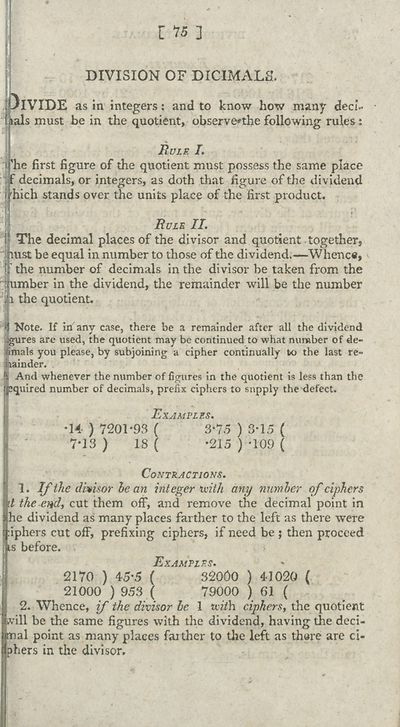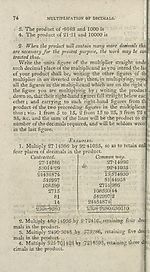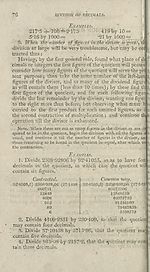Download files
Complete book:
Individual page:
Thumbnail gallery: Grid view | List view

E 15 ]
DIVISION OF DICIMALS.
)lVIDE in integers: and to know how many deci-
tals must be in the quotient, observe»the following rules:
Rule I.
' 'he first figure of the quotient must possess the same place
f decimals, or integers, as doth that figure of the dividend
hich stands over the units place of the first product.
Rule II.
! The decimal places of the divisor and quotient. together,
" mst be equal in number to those of the dividend.—Whence,
’ the number of decimals in the divisor be taken from the
umber in the dividend, the remainder will be the number
i the quotient.
‘ Note. If in any case, there be a remainder after all the dividend
gures are used, the quotient may be continued to what number of de¬
nials you please, by subjoining a cipher continually to the last re¬
minder.
And whenever the number of figures in the quotient is less than the
:quired number of decimals, prefix ciphers to supply the-defect.
Examples.
•14 ) 7201*93 ( 3-75 ) 3-15 (
7*13 ) 18 ( -215 ) -109 (
Contractions.
1. If the divisor be an integer ‘with any number of ciphers
't the end, cut them off, and remove the decimal point in
he dividend as many places farther to the left as there were
:iphers cut off, prefixing ciphers, if need be ; then proceed
is before.
Examples.
2170 ) 45-5 ( 32000 ) 41020 (
21000 ) 953 ( 79000 ) 61 (
2. Whence, f the divisor be 1 tt-zVh ciphers, the quotient
will be the same figures with the dividend, having the deci¬
mal point as many places farther to tire left as there are ci¬
phers in the divisor.
DIVISION OF DICIMALS.
)lVIDE in integers: and to know how many deci-
tals must be in the quotient, observe»the following rules:
Rule I.
' 'he first figure of the quotient must possess the same place
f decimals, or integers, as doth that figure of the dividend
hich stands over the units place of the first product.
Rule II.
! The decimal places of the divisor and quotient. together,
" mst be equal in number to those of the dividend.—Whence,
’ the number of decimals in the divisor be taken from the
umber in the dividend, the remainder will be the number
i the quotient.
‘ Note. If in any case, there be a remainder after all the dividend
gures are used, the quotient may be continued to what number of de¬
nials you please, by subjoining a cipher continually to the last re¬
minder.
And whenever the number of figures in the quotient is less than the
:quired number of decimals, prefix ciphers to supply the-defect.
Examples.
•14 ) 7201*93 ( 3-75 ) 3-15 (
7*13 ) 18 ( -215 ) -109 (
Contractions.
1. If the divisor be an integer ‘with any number of ciphers
't the end, cut them off, and remove the decimal point in
he dividend as many places farther to the left as there were
:iphers cut off, prefixing ciphers, if need be ; then proceed
is before.
Examples.
2170 ) 45-5 ( 32000 ) 41020 (
21000 ) 953 ( 79000 ) 61 (
2. Whence, f the divisor be 1 tt-zVh ciphers, the quotient
will be the same figures with the dividend, having the deci¬
mal point as many places farther to tire left as there are ci¬
phers in the divisor.
Set display mode to:
![]() Universal Viewer |
Universal Viewer | ![]() Mirador |
Large image | Transcription
Mirador |
Large image | Transcription
| Antiquarian books of Scotland > Education > Complete treatise on practical arithmetic and book-keeping > (89) |
|---|
| Permanent URL | https://digital.nls.uk/114434638 |
|---|
| Description | Thousands of printed books from the Antiquarian Books of Scotland collection which dates from 1641 to the 1980s. The collection consists of 14,800 books which were published in Scotland or have a Scottish connection, e.g. through the author, printer or owner. Subjects covered include sport, education, diseases, adventure, occupations, Jacobites, politics and religion. Among the 29 languages represented are English, Gaelic, Italian, French, Russian and Swedish. |
|---|

